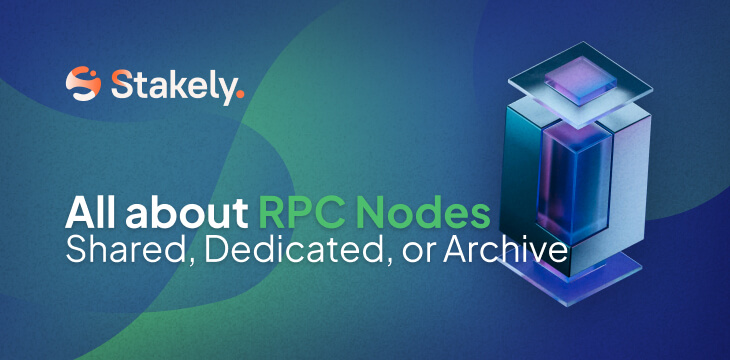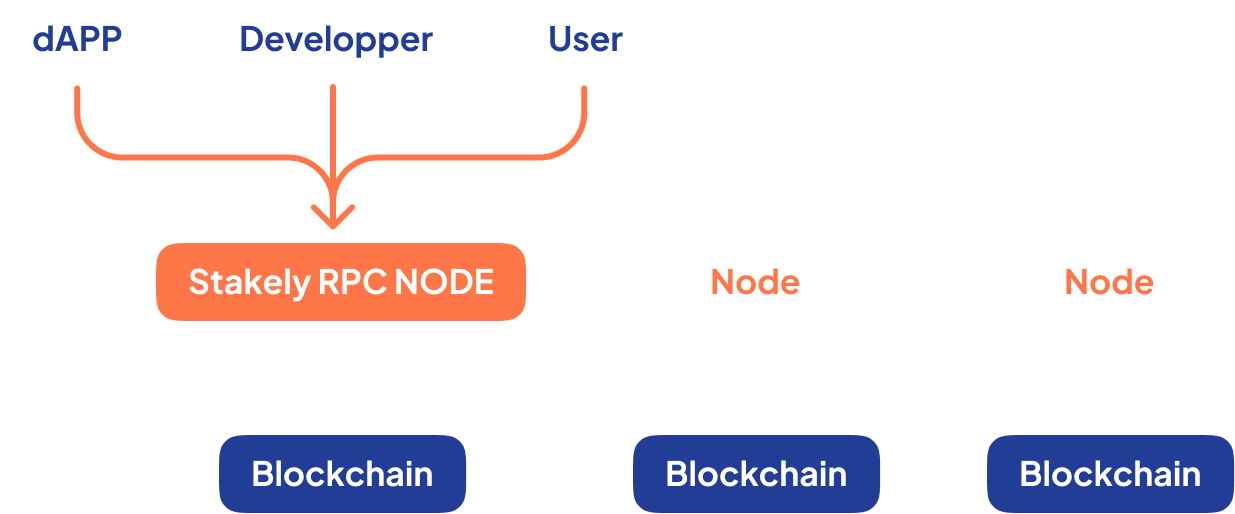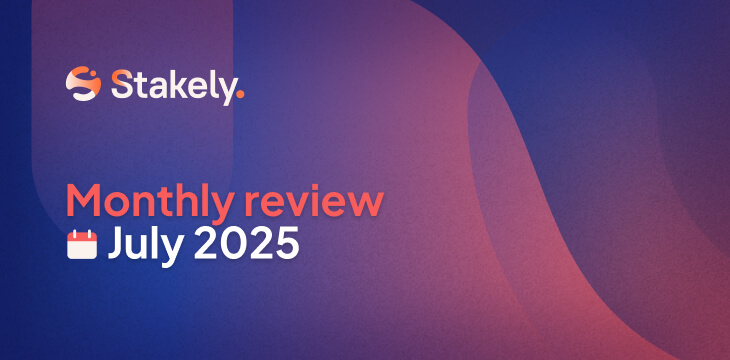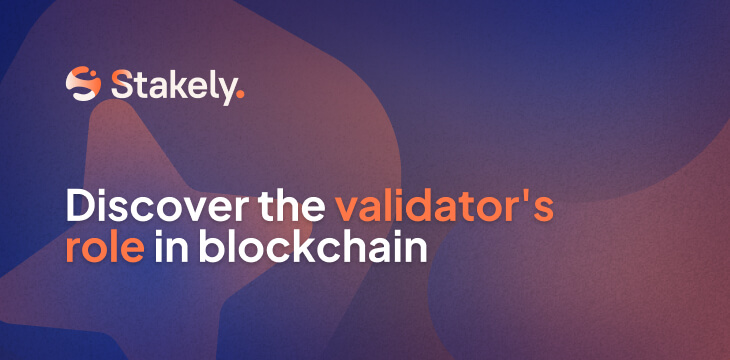Dedicated vs Archive RPC Nodes: Why your dApp needs them in 2025

If you’re building a decentralized application in 2025, choosing the right RPC node isn’t just a bonus—it’s a critical technical decision. Whether you’re executing transactions, powering real-time dashboards, or indexing historical data, your infrastructure’s reliability and performance directly depend on the type of RPC node you use.
In this article, we explain the differences between shared, dedicated, and archive RPC nodes, and why services like Stakely’s can save you time, costs, and operational risks.
What is an RPC node?
An RPC node (Remote Procedure Call) is the access point for an application to connect to the blockchain. It allows querying information, sending transactions, and staying in sync with the current or historical state of the network—without requiring the app to run its own full node.
Thanks to RPC nodes, dApps, wallets, explorers, and bots can:
- Read balances and account states
- Query smart contract data
- Send signed transactions
- Listen for new blocks or events
For example, when you perform a swap on a DEX, the dApp’s front-end connects to an RPC node to check your balance, simulate the transaction, and send the final transaction. All of this depends on the node being available, up-to-date, and running with low latency.
This all happens in real time and is transparent to the user, but it’s made possible by the RPC node that connects the interface to the blockchain. So, if you’re developing a Web3 application, you’ll need an RPC node to access on-chain data and maintain a stable connection to the network.
Diagram of an RPC node
[dApp] → (RPC request) → [RPC Node] → Blockchain


Differences between RPC nodes: dedicated, shared, and archive
Each type of RPC node is designed to meet different technical and business needs. Depending on your budget, workload, and intended use, you can choose from three options:
Shared RPC Node: the most cost-effective option. Ideal for test or development environments. They share capacity with other users and usually have request-per-minute limits.
Dedicated RPC Node: a completely isolated node, with exclusive access, no interference from other clients, and consistent performance. Delivers high throughput and no request limits. Perfect for production environments where stability and speed are key.
Archive RPC Node: a dedicated node with full access to the blockchain’s history, from the genesis block. Required for tasks like block reconstruction, auditing, or advanced historical analytics.
| Node Type | Performance | Access | Request Limits | Use Cases |
|---|---|---|---|---|
| Shared | High | Shared | Rate-limited | Testnets, MVPs, low-traffic dApps |
| Dedicated | Very high | Exclusive | No limits | Production, wallets, MEV bots, backends |
| Archive | Very high | Exclusive + Historical | No limits | Indexers, analytics, explorers, auditing |
Real-world use cases for each RPC node type
Here are real-world scenarios where each type of RPC node makes sense, with practical examples from the ecosystem:
Shared Node
- Rapid dApp development and proof-of-concepts: ideal when your team needs to launch a frontend in a few hours without investing in its own infrastructure.
- Internal dashboards or data panels: to view staking metrics or delegator activity with light queries and no critical SLAs.
- “Long tail” integrations: scripts that notify via Telegram when rewards arrive, or plugins that display your balance on Ledger Live: low traffic, high impact.
Dedicated Node
- High-throughput DeFi applications: AMMs, lending protocols, or wallets signing hundreds of transactions per minute need low latency and guaranteed bandwidth.
- MEV and arbitrage bots: milliseconds decide profit: queue-free access and peer priority improve your odds.
- Real-time alerting and monitoring systems: trigger alerts in <5s if your validator misses a block or gas price spikes; requires stable WebSockets with no rate-limits.
Archive Node
- Historical analysis and backtesting: if you need every EVM state from the genesis block to train risk models or quantitative trading strategies.
- Advanced block explorers: showing storage changes, balances, and traces at any past block requires full state-diff data.
- Smart contract audits: reviewing how a contract variable has evolved over months or years is only possible with a full archive node.
Why does choosing the right RPC provider matter?
Your app is only as reliable as the RPC node it connects to. If your endpoint goes down, your users feel it immediately. Slow interface, stuck transactions, outdated data… it all starts with a poorly configured node.
A good RPC service should be fast, stable, and easy to scale. But not all providers deliver. Some throttle traffic, others require support tickets for everything, and many simply aren’t production-ready.
Choosing a solid RPC provider means:
- Low latency from the end user’s region
- High availability (at least 99.9% uptime)
- Scalability and exclusive use options
- Ability to access full historical data (archive)
- Clear billing, no surprise traffic overcharges
What does Stakely offer?
Stakely is not just another RPC provider. We’ve been validator operators since 2020, active on over 35 blockchains with more than $1 billion in delegated staking.
With our RPC node service, you get:
- Fast provisioning (within hours; Archive in 24–48h)
- Geo-distributed infrastructure with guaranteed low latency
- 99.9% SLA availability
- Shared, dedicated, and archive nodes
- Fixed pricing with no surprises
- Self-service dashboard, no tickets or wait times
- 24/7 human support via email or Telegram
- ISO 27001 certification and SOC 2 audit in progress
- Pay with crypto
- Flexible cancellation at any time
FAQs
What is an RPC node?
An RPC node (Remote Procedure Call) allows you to interact with the blockchain through a standard API. It’s the access point used by wallets, explorers, and dApps to read data or send transactions.
What is a dedicated RPC node?
A dedicated RPC node is reserved exclusively for your use. It doesn’t share resources with other users, ensuring consistent performance, low latency, and no rate limits. Ideal for critical production environments.
What’s the difference between a Full and an Archive node?
A full node keeps the current state of the network and recent blocks. An archive node, on the other hand, stores the entire history from genesis, enabling queries on any past state. It’s essential for analytics, indexing, or auditing tasks.





